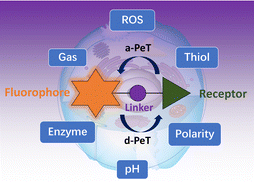Photoinduced electron transfer (PeT) based fluorescent probes for cellular imaging and disease therapy†
Abstract
Typical PeT-based fluorescent probes are multi-component systems where a fluorophore is connected to a recognition/activating group by an unconjugated linker. PeT-based fluorescent probes are powerful tools for cell imaging and disease diagnosis due to their low fluorescence background and significant fluorescence enhancement towards the target. This review provides research progress towards PeT-based fluorescent probes that target cell polarity, pH and biological species (reactive oxygen species, biothiols, biomacromolecules, etc.) over the last five years. In particular, we emphasise the molecular design strategies, mechanisms, and application of these probes. As such, this review aims to provide guidance and to enable researchers to develop new and improved PeT-based fluorescent probes, as well as promoting the use of PeT-based systems for sensing, imaging, and disease therapy.



 Please wait while we load your content...
Please wait while we load your content...